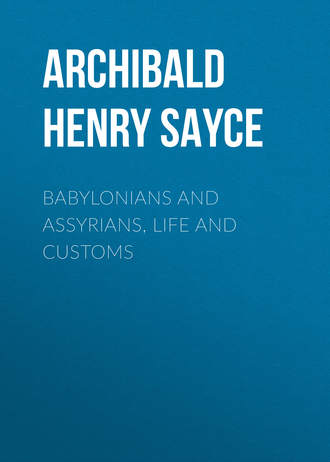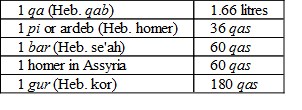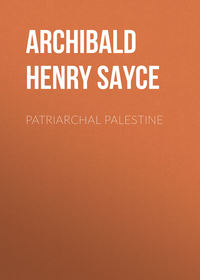 полная версия
полная версияBabylonians and Assyrians, Life and Customs
The man who could thus pray was not far from the kingdom of God.
Appendix: Weights And Measures
In the preceding pages the equivalence of the qa in modern English measures has been given in accordance with the calculations of Dr. Oppert. Other scholars, however, would assign to it a different value, identifying it with the Hebrew qab and making it equal to about two litres. This, indeed, seems to have been its value in the age of Abraham, but in the later days of Babylonian history a different system certainly prevailed.
Weights
The silver maneh was equivalent to £9, the shekel being 3s., while the gold maneh was ten times its value. The maneh was originally a weight more than one kind of which was in use: (1) The heavy maneh of 990 grammes; (2) the light maneh of 495 grammes; (3) the gold maneh (for weighing gold) of 410 grammes; and (4) the silver maneh of 546 grammes. At Sippara, however, the heavy maneh weighed 787 grammes; the light maneh, 482 grammes; and the gold maneh, 392 grammes; while the standard maneh fixed by Dungi weighed 980 grammes. The maneh of Carchemis contained 561 grammes.
Measures of Capacity
In the Abrahamic age other systems were in use in Babylonia according to which the gur sometimes contained 360 qas and sometimes 300 qas.
The tonnage of ships was reckoned by the gur.
Measures of Length
In the Abrahamic age 180 se were probably equivalent to 1 gin, 60 gin to one sar or “garden,” 1,800 sar to 1 feddân (padânu) or “acre.” The latter was called bur-gan in Sumerian, or “10 acres,” to distinguish it from a smaller acre, which contained only 180 sar.
Time was reckoned by the kasbu or “double hour,” and in early times the weight was divided into three watches of 2 kasbus or 4 hours each. The months were originally lunar, and consisted of 30 days, an intercalary month being inserted in the calendar every six years. The zodiac was divided into 360 degrees.
Mathematics were based upon a sexagesimal system, sixty, called the soss, being the unit. The ner was equivalent to 10 sosses and the sar to 6 ners.
1
Researches in Assyria, Babylonia, and Chaldea (1838), p. 131 sqq.
2
In certain cases the wife seems to have had the power of claiming alimony from her husband, though we do not know what were the circumstances which were held sufficient to justify the claim. Thus, in the third year of Nabonidos, “Nahid-Merodach, the son of Samas-baladhu-iqbi, voluntarily granted his wife Ramûa and his son Arad-Bunene four qas of food and three qas of beer daily, as well as fifteen manehs of wool, one pi of sesame, one pi of salt, and sixty qas of sweetmeats each year,” with the provision that the grant should never be cancelled or willed away. The son, however, is included in the gift, and it is possible, therefore, that Ramûa was little more than a concubine.
3
A similar case, in which, however, it is a testatrix who hands over her property to her son during her lifetime, is recorded in a deed dated at Babylon the 10th day of Sivân, in the second year of Nabonidos. The deed is as follows: “Gugûa, the daughter of Zakir, the son of a native of Isin, has voluntarily sealed and delivered to her eldest son, Ea-zir-ibni, her dowry, consisting of one maneh which is in the keeping of Nebo-akhi-iddin, the son of Sula, the son of Egibi; 35 shekels which have been mortgaged to Tabnea, the son of Nebo-yusallim, the son of Sin-sadunu, and 20 shekels which are due from Tasmetum-ramat, the daughter of Arad-Bel, the son of Egibi, as well as a field producing 48 qas of seed on the canal of Kish. As regards the maneh and 56 shekels belonging to Gugûa, which, in the absence of her eldest son, Ea-zir-ibni, she has divided between her younger sons, Nebo-akhi-bullidh, Nergal-ina-esi-edher, Itti-Samas-baladhu, and Ninip-pir-utsur, Ea-zir-ibni shall have no claim to them. Gugûa has delivered to Ea-zir-ibni, her eldest son, one maneh, now in the hands of Nebo-akhi-iddin, 55 shekels in the hands of Tabnea, 50 shekels in the hands of Tasmetum-ramat, and a field bearing 48 qas of seed. As long as Gugûa lives, Ea-zir-ibni shall give his mother Gugûa, as interest upon the property, food and clothing. Gugûa shall alienate none of it out of affection or will it away. Ea-zir-ibni shall not be disturbed in his possession.” The names of three witnesses are attached to the deed, which was “sealed in the presence of Babâ, the daughter of Nebo-zir-lisir, the son of Egibi.”
4
Journal of the American Oriental Society, xviii., p. 167.
5
We hear, however, of a “little girl of six years of age” being sold for 17 shekels in the thirteenth year of Nabonidos, but she was doubtless an orphan.
6
Xxiii. 14.
7
Schliemann, Ilios, pp. 471, 472. Mr. Head shows that the maneh in question is identical with the Babylonian silver maneh of 8,656 grains troy, or 561 grammes, though the latter is now more usually fixed at 546 grammes.
8
In the Assyrian texts the term for “prison” is bit kili, of which kisukku is also given as a synonym.
9
Our learned author has been misled in this paragraph by the utterly erroneous copy and translation of Father Scheil. The letter reads “To Sin-iddinnam from Hammurabi. The goddesses of Emutbalim which are assigned to thee, the troops under the command of Tnuhsamar will bring to thee in safety. When they reach thee, with the troops which thou hast destroy the people, and the goddesses to their dwellings let them bring in safety.”—Cr.


